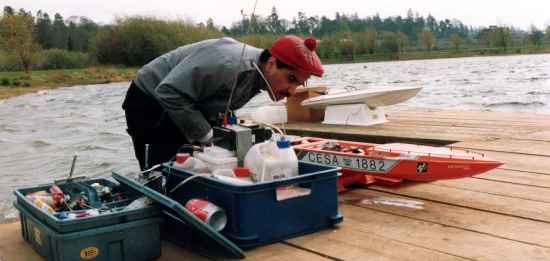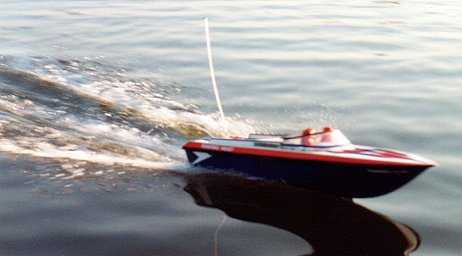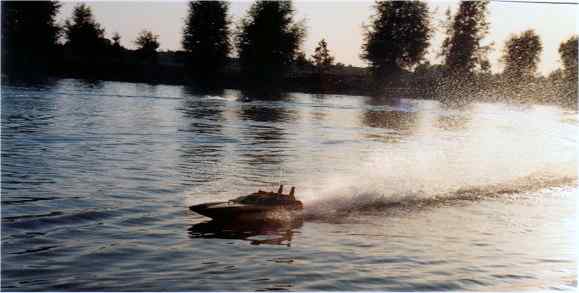| STARTING UP |
|
|
|
With installation complete, we can start thinking about getting the engine started. Modellers in "the good old days" used to start the engine by a pull cord 'see-sawed' around the flywheel, but now we all use powerful electric starters that will start even the most stubborn engines. To start the engine you will need fuel, fuel pump, plug spanner, plug power clip, 1.5 volt battery, 12 volt battery, electric starter, starter belts and something to carry it all in. Power panels are available that supply power to the starter and glow plug and a built in fuel pump. A small 'v' belt is left loose under the flywheel during installation, the starter is pulled against this belt to turn the engine over. By now you will have checked the boat from bow to stern at least twenty times looking for flaws. Once you are happy with your craftsmanship, you can take all the gear out to the back garden or go for a short drive to the local boating lake. At the lake side you will need to do a range check for the radio first and check that your frequency is clear by asking any other boaters nearby. Next press-gang someone into checking your boat while you walk away from it with the Tx aerial down. You should be able to walk at least a fifty yards and still have full control of rudder and throttle. If you can't keep control of the boat or the servos start twitching, don't launch. Go home and find what the problem is. Twitching is usually caused by metal to metal joints so a couple of earth straps soldered / fixed to the stuffing tube, engine mount and rudder might be in order. Don't think "I'll try the boat anyway" because you don't want to loose or smash your new boat on it's first outing. Happy with the radio? Remove the plug and squirt a little 3-in-1 oil into the carb, cover the hole with a rag and then spin the engine over gently with the starter. This will make sure that the engine is clean and well lubricated. Now the easiest way to actually get your first engine going is by getting someone else to do it for you! It will save you a lot of time and frustration. Starting and getting IC engines running properly seems to be the most temperamental aspect of model boating. However if you keen to do on your own then you might get lucky.....! Check the glow plug is working and screw it in tight but don't use all your strength. (Once the engine is running the plug can be tightened a little more if you see small fizzing bubbles.) Fill the tank with fuel and open the needle valve 2 or 3 turns ( don't touch it if it's a brand new engine - it's already been set). Switch on the transmitter first then the receiver.
Check the rudder swings an even
amount each side of centre ( Looking from the back of
the boat, the rudder should swing the same way as the rudder stick on your
transmitter) and the throttle opens and closes fully
without straining the servo. Check your starter is turning the right
way, clockwise, and pull it up under the belt. Set the throttle on the
transmitter about third open, place a finger over the carb air intake
and spin the engine over with the starter until you can see fuel being
drawn up the fuel line and into the carb. Connect the glow plug clip
and we are ready to start the engine. Spin over the starter again and
with any luck the engine should burst in to life after a second or so.
And that's all there is to it! |
|
|
|
OK so the engine didn't start, what do we do next? First check that fuel is reaching the carb by using the above method again. Try different throttle settings while starting. Next open the needle valve by a quarter turn. The valve should be turned by very small amounts, a small file mark or a spot of paint on the valve will indicate how much you turned it. Repeat these steps until you get some sign of life from the engine. Remove the plug and check it still glows when connected to the clip, blow out any residue fuel and try to start it again. Try a different plug. If by now the needle valve is 10 turns open, screw it back to close it and start again from 2 turns, a quarter turn at time. If there are bubbles in the fuel look along the fuel line and tank for leaks. If the fuel comes to the carb and then pulls itself back to the tank, check the tank is vented properly or the pressure pluming is correct. It the engine suddenly does stiff, it's flooded and the plug will have to be removed and the fuel spun out using the starter motor, cover the plug hole with a rag or the fuel will cover you! With the plug removed the engine should be able to be spun over quite freely in your fingers unless it's an ABC engine in which case it might be a little stiff at the top of the stroke but it's meant to be like that. With the plug, out check that everything looks OK and nothing has come loose. While you're at it, remove the needle valve and blow through the carb with a spare bit of fuel tube to check it's still clear. Replace the needle valve and fuel line and spin the engine over without the plug, you should see a fine mist of fuel coming out of the top, adjust the valve until you just can. By the way, don't pull too hard on the starter as some over zealous boaters have pulled the engine clean out of the bottom of the boat when trying too hard! If the belt slips, clean it and everything else down with a dry rag. After a another 'short while' YOU WILL have the engine running. Powerful and noisy isn't it? Starting becomes easier with practice and once the engine is run in. The engine can be run out of the water and without cooling for short periods but DON'T LET THE ENGINE REV TOO HIGH. (For testing at home, water cooling can be provided by syphoning from a large bottle above the engine to a lower bottle via the boats complete cooling system.) Adjust the throttle to see what difference it makes. If the engine is making a unhappy gurgling sound but continues running then the mixture is too rich and the engine is "four stroking" and the engine is firing every second revolution instead of every time, screw in the valve slowly until the engine just changes to a faster steady tone. If the engine screams and begs for mercy, quickly stop it by sticking your finger over the carb, open the valve a quarter turn and restart. If the engine stalls as soon as you take the glow clip off, remove the plug and check to see that the element has an even red glow for at least 3 turns, if not try another plug. Adjust the throttle and needle valve until you can attain and nice steady fast idle.
If after a 100 attempts you
still can't get the engine going, don't panic. At this stage, give
up, pack everything away, go home and get yourself a nice cup of tea!
Find out when the local boat club next meets, (you should have joined
already to use the lake anyway!!! ) and arrange to meet with them. Find out who is
good with IC engines and seek help from him. He'll be able to check
re-check your handiwork and will be able to get your boat going
without too much difficulty. Joining the club will also give you third
party insurance on your boat, but not against other model boats
unfortunately. |
|
More about starting engines.... |
|
http://rcvehicles.about.com/library/aircraft/blair_starting.htm www.ic-online.co.uk/eng1.htm |
|
|
| MAIDEN VOYAGE! |
|
|
|
Great, your engine is now running sweetly and 'sounds right'. Now stand in the water up to you shins. Of course, if your feet are suddenly all wet then you should have put your wellies on first, do I have to tell you everything! Now lift the boat off the stand, being mindful of the propeller and place the boat in the water with the bows between your shins. The boat should stall, it always does the first time it touches the water, put the boat back on it's stand and restart with the throttle open a little more. If it stalls even at a high throttle, open the valve a couple of clicks and/or try a smaller prop. When you've got the boat running steadily in the water, rev the engine via the transmitter to see if you can achieve a smooth acceleration over the whole range but not worrying too much about the top end. Adjust the valve a little bit each way until the engine can be revved quite high without stalling. Check water is coming out of the cooling outlet and everything is still secure. If your boat has surface drive then it's mainly trial and error over many short runs to get a good needle setting.
You are now ready to let go of your boat on it's maiden voyage. Leave
the hatch off for the first few runs. Turn the boat
around and hold it with one hand, near the transom and
pointing outwards towards the middle of the lake. With
the transmitter in your other hand, make a final check
that you have full rudder and throttle control
and let go!... |
|
|
|
Having fun yet? Good isn't it! Don't accelerate just yet, you'll have enough to worry about just steering the thing as it may cover a lot of water very quickly. Don't take your eyes of it for a second whatever you do. Try a large circle to the right and then to the left, still OK? EXCELLENT!
Don't be
tempted to accelerate just yet for three reasons.
|
|
|
|
How do you bring your boat in safely? Never head the boat straight at yourself or the jetty as sooner so later you'll have an embarrassing accident. Bring the boat in slowly and at a shallow angle so in case you mess it up you can veer off and go around for another attempt. If you engine is set-up like mine (see above) then you can shut the engine down in the final approach or while passing close the along the front of the jetty. If you don't have access to a jetty or landing stage choose your bit of bank very carefully as you don't follow your boat into the water when launching! After each of the first few runs, completely check the boat over again from bow to stern looking for any possible faults.
Well
all of this is just my opinion, but what do I know! |



